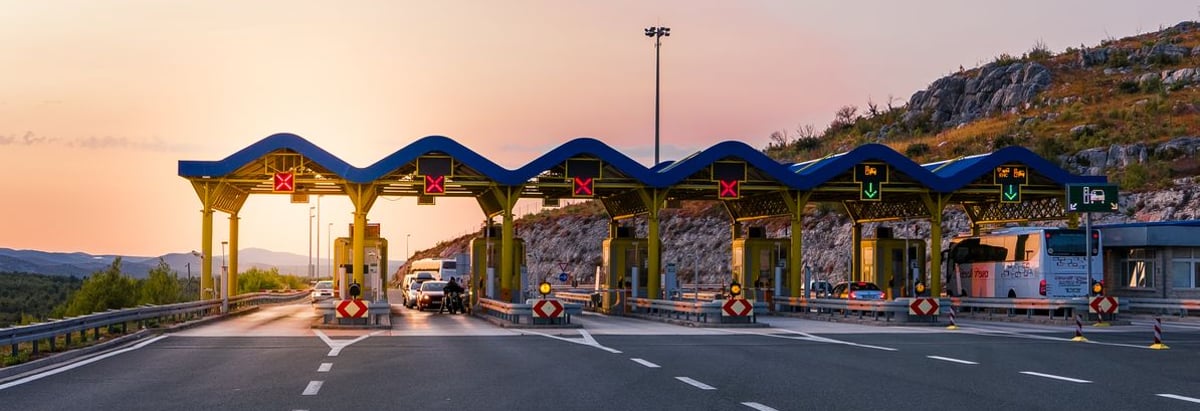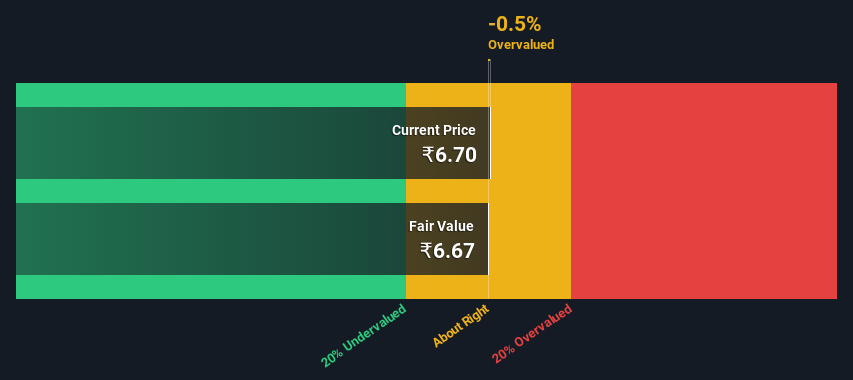- India
- /
- Infrastructure
- /
- NSEI:NOIDATOLL
Estimating The Fair Value Of Noida Toll Bridge Company Limited (NSE:NOIDATOLL)

In this article we are going to estimate the intrinsic value of Noida Toll Bridge Company Limited (NSE:NOIDATOLL) by taking the forecast future cash flows of the company and discounting them back to today's value. This will be done using the Discounted Cash Flow (DCF) model. Don't get put off by the jargon, the math behind it is actually quite straightforward.
We would caution that there are many ways of valuing a company and, like the DCF, each technique has advantages and disadvantages in certain scenarios. For those who are keen learners of equity analysis, the Simply Wall St analysis model here may be something of interest to you.
Check out our latest analysis for Noida Toll Bridge
Is Noida Toll Bridge Fairly Valued?
We are going to use a two-stage DCF model, which, as the name states, takes into account two stages of growth. The first stage is generally a higher growth period which levels off heading towards the terminal value, captured in the second 'steady growth' period. To begin with, we have to get estimates of the next ten years of cash flows. Seeing as no analyst estimates of free cash flow are available to us, we have extrapolate the previous free cash flow (FCF) from the company's last reported value. We assume companies with shrinking free cash flow will slow their rate of shrinkage, and that companies with growing free cash flow will see their growth rate slow, over this period. We do this to reflect that growth tends to slow more in the early years than it does in later years.
A DCF is all about the idea that a dollar in the future is less valuable than a dollar today, so we discount the value of these future cash flows to their estimated value in today's dollars:
10-year free cash flow (FCF) forecast
| 2023 | 2024 | 2025 | 2026 | 2027 | 2028 | 2029 | 2030 | 2031 | 2032 | |
| Levered FCF (₹, Millions) | ₹88.7m | ₹104.7m | ₹120.1m | ₹134.8m | ₹149.2m | ₹163.3m | ₹177.5m | ₹192.0m | ₹206.8m | ₹222.2m |
| Growth Rate Estimate Source | Est @ 22.80% | Est @ 18.00% | Est @ 14.64% | Est @ 12.29% | Est @ 10.65% | Est @ 9.50% | Est @ 8.69% | Est @ 8.13% | Est @ 7.73% | Est @ 7.46% |
| Present Value (₹, Millions) Discounted @ 16% | ₹76.4 | ₹77.7 | ₹76.7 | ₹74.2 | ₹70.7 | ₹66.7 | ₹62.5 | ₹58.2 | ₹54.0 | ₹50.0 |
("Est" = FCF growth rate estimated by Simply Wall St)
Present Value of 10-year Cash Flow (PVCF) = ₹667m
We now need to calculate the Terminal Value, which accounts for all the future cash flows after this ten year period. For a number of reasons a very conservative growth rate is used that cannot exceed that of a country's GDP growth. In this case we have used the 5-year average of the 10-year government bond yield (6.8%) to estimate future growth. In the same way as with the 10-year 'growth' period, we discount future cash flows to today's value, using a cost of equity of 16%.
Terminal Value (TV)= FCF2032 × (1 + g) ÷ (r – g) = ₹222m× (1 + 6.8%) ÷ (16%– 6.8%) = ₹2.6b
Present Value of Terminal Value (PVTV)= TV / (1 + r)10= ₹2.6b÷ ( 1 + 16%)10= ₹575m
The total value, or equity value, is then the sum of the present value of the future cash flows, which in this case is ₹1.2b. In the final step we divide the equity value by the number of shares outstanding. Relative to the current share price of ₹6.7, the company appears around fair value at the time of writing. The assumptions in any calculation have a big impact on the valuation, so it is better to view this as a rough estimate, not precise down to the last cent.

The Assumptions
We would point out that the most important inputs to a discounted cash flow are the discount rate and of course the actual cash flows. If you don't agree with these result, have a go at the calculation yourself and play with the assumptions. The DCF also does not consider the possible cyclicality of an industry, or a company's future capital requirements, so it does not give a full picture of a company's potential performance. Given that we are looking at Noida Toll Bridge as potential shareholders, the cost of equity is used as the discount rate, rather than the cost of capital (or weighted average cost of capital, WACC) which accounts for debt. In this calculation we've used 16%, which is based on a levered beta of 0.954. Beta is a measure of a stock's volatility, compared to the market as a whole. We get our beta from the industry average beta of globally comparable companies, with an imposed limit between 0.8 and 2.0, which is a reasonable range for a stable business.
SWOT Analysis for Noida Toll Bridge
- Net debt to equity ratio below 40%.
- Current share price is above our estimate of fair value.
- Has sufficient cash runway for more than 3 years based on current free cash flows.
- Lack of analyst coverage makes it difficult to determine NOIDATOLL's earnings prospects.
- Debt is not well covered by operating cash flow.
Moving On:
Although the valuation of a company is important, it ideally won't be the sole piece of analysis you scrutinize for a company. It's not possible to obtain a foolproof valuation with a DCF model. Instead the best use for a DCF model is to test certain assumptions and theories to see if they would lead to the company being undervalued or overvalued. For example, changes in the company's cost of equity or the risk free rate can significantly impact the valuation. For Noida Toll Bridge, we've put together three relevant elements you should assess:
- Risks: To that end, you should be aware of the 2 warning signs we've spotted with Noida Toll Bridge .
- Other High Quality Alternatives: Do you like a good all-rounder? Explore our interactive list of high quality stocks to get an idea of what else is out there you may be missing!
- Other Top Analyst Picks: Interested to see what the analysts are thinking? Take a look at our interactive list of analysts' top stock picks to find out what they feel might have an attractive future outlook!
PS. Simply Wall St updates its DCF calculation for every Indian stock every day, so if you want to find the intrinsic value of any other stock just search here.
Valuation is complex, but we're here to simplify it.
Discover if Noida Toll Bridge might be undervalued or overvalued with our detailed analysis, featuring fair value estimates, potential risks, dividends, insider trades, and its financial condition.
Access Free AnalysisHave feedback on this article? Concerned about the content? Get in touch with us directly. Alternatively, email editorial-team (at) simplywallst.com.
This article by Simply Wall St is general in nature. We provide commentary based on historical data and analyst forecasts only using an unbiased methodology and our articles are not intended to be financial advice. It does not constitute a recommendation to buy or sell any stock, and does not take account of your objectives, or your financial situation. We aim to bring you long-term focused analysis driven by fundamental data. Note that our analysis may not factor in the latest price-sensitive company announcements or qualitative material. Simply Wall St has no position in any stocks mentioned.
About NSEI:NOIDATOLL
Noida Toll Bridge
Engages in the development, establishment, construction, operation, and maintenance of Delhi Noida toll bridge on a build-own-operate-transfer basis in India.
Adequate balance sheet low.
Market Insights
Community Narratives



